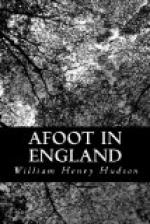The service over, we rambled an hour longer in the wood, then returned to our village, which had a church of its own, and our landlady, hearing where we had been, told us the story, or tradition, of the little church in the wood. Its origin goes very far back to early Norman times, when all the land in this part was owned by one of William’s followers on whom it had been bestowed. He built himself a house or castle on the edge of the forest, where he lived with his wife and two little daughters who were his chief delight. It happened that one day when he was absent the two little girls with their female attendant went into the wood in search of flowers, and that meeting a wild boar they turned and fled, screaming for help. The savage beast pursued, and, quickly overtaking them, attacked the hindermost, the youngest of the two little girls, anal killed her, the others escaping in the meantime. On the following day the father returned, and was mad with grief and rage on hearing of the tragedy, and in his madness resolved to go alone on foot to the forest and search for the beast and taste no food or drink until he had slain it. Accordingly to the forest he went, and roamed through it by day and night, and towards the end of the following day he actually found and roused the dreadful animal, and although weakened by his long fast and fatigue, his fury gave him force to fight and conquer it, or else the powers above came to his aid; for when he stood spear in hand to wait the charge of the furious beast he vowed that if he overcame it on that spot he would build a chapel, where God would be worshipped for ever. And there it was raised and has stood to this day, its doors open every Sunday to worshippers, with but one break, some time in the sixteenth century to the third year of Elizabeth, since when there has been no suspension of the weekly service.
That the tradition is not true no one can say. We know that the memory of an action or tragedy of a character to stir the feelings and impress the imagination may live unrecorded in any locality for long centuries. And more, we know or suppose, from at least one quite familiar instance from Flintshire, that a tradition may even take us back to prehistoric times and find corroboration in our own day.
But of this story what corroboration is there, and what do the books say? I have consulted the county history, and no mention is made of such a tradition, and can only assume that the author had never heard it—that he had not the curious Aubrey mind. He only says that it is a very early church —how early he does not know—and adds that it was built “for the convenience of the inhabitants of the place.” An odd statement, seeing that the place has every appearance of having always been what it is, a forest, and that the inhabitants thereof are weasels, foxes, jays and such-like, and doubtless in former days included wolves, boars, roe-deer and stags, beings which, as Walt Whitman truly remarks, do not worry themselves about their souls.




